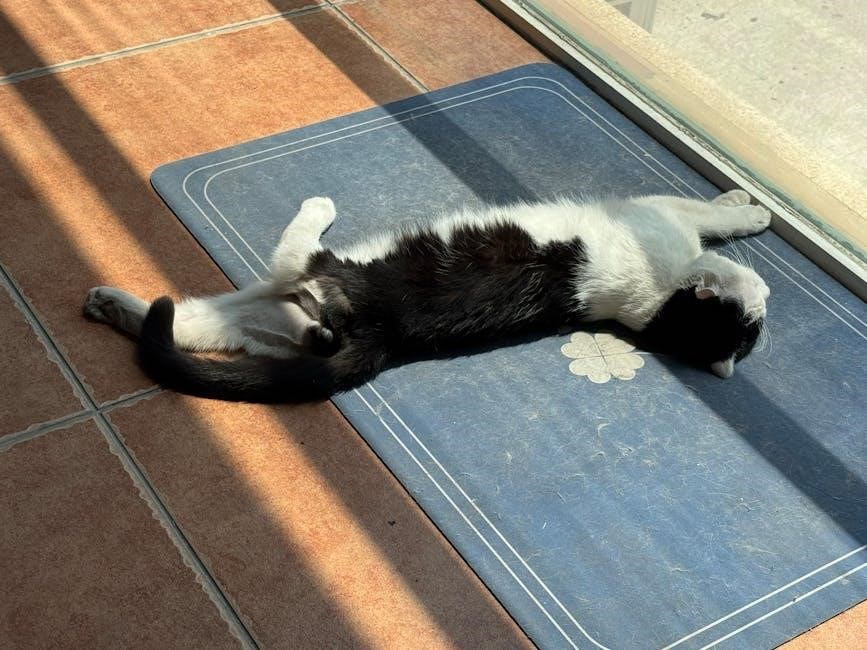Proprioceptive Neuromuscular Facilitation (PNF) is a stretching method enhancing flexibility and muscle strength through neuromuscular responses. Widely used in therapy and sports, it employs techniques like hold-relax and contract-relax to improve mobility and recovery.
1.1 Definition and Purpose
Proprioceptive Neuromuscular Facilitation (PNF) stretching is a technique leveraging neuromuscular responses to enhance flexibility and strength. It involves alternating muscle contractions and relaxations to improve joint mobility and reduce stiffness. PNF aims to optimize physical performance, prevent injuries, and aid recovery, making it a versatile tool in both athletic training and rehabilitation settings.
1.2 Historical Background
Proprioceptive Neuromuscular Facilitation (PNF) was developed in the 1940s by Dr. Herman Kabat and his associates. Initially used in clinical settings, it aimed to enhance motor control and rehabilitation for patients with neurological conditions. PNF gained popularity in the 1960s and 1970s, expanding into sports and physical therapy, integrating techniques like joint mobilization to improve flexibility and performance.
Key PNF Stretching Techniques
PNF techniques include hold-relax, contract-relax, and agonistic reversal. These methods combine active muscle contractions with passive stretching to enhance flexibility, strength, and neuromuscular coordination, benefiting both therapy and sports.
2.1 Hold-Relax Technique
The hold-relax technique involves passively stretching a muscle to its limit, holding for 5-10 seconds, then relaxing. A brief isometric contraction follows, enhancing neuromuscular relaxation. This method effectively reduces muscle tension and improves joint range of motion, making it a cornerstone in PNF stretching for rehabilitation and athletic training.
2.2 Contract-Relax Technique
The contract-relax technique involves isometrically contracting the target muscle for 5-10 seconds, followed by relaxation and a passive stretch. This method leverages neuromuscular responses to reduce muscle resistance, enhancing flexibility and range of motion. It is particularly effective for improving joint mobility and reducing muscle tension, making it a key component of PNF stretching protocols.
2.3 Agonistic and Antagonistic Reversal Techniques
Agonistic techniques focus on contracting the primary muscle group, while antagonistic reversal involves alternating contractions between agonists and antagonists. These methods enhance neuromuscular coordination and flexibility by utilizing reflex responses. They are particularly effective in improving functional movement patterns and joint mobility, making them integral to advanced PNF stretching routines for both rehabilitation and athletic training.

Benefits of PNF Stretching
PNF stretching enhances flexibility, muscle strength, and recovery while reducing hypertonus. It improves joint mobility and neuromuscular coordination, benefiting both rehabilitation and athletic performance.
3.1 Improved Flexibility and Range of Motion
PNF stretching enhances flexibility by targeting neuromuscular responses, allowing deeper stretches. Techniques like hold-relax and contract-relax reduce muscle tension, improving joint mobility. Regular practice breaks down scar tissue and realigns muscle fibers, increasing range of motion. This makes PNF highly effective for rehabilitation and athletic performance, promoting functional movement and reducing stiffness in both acute and chronic conditions.
3.2 Enhanced Muscle Strength and Recovery
PNF stretching not only improves flexibility but also enhances muscle strength and recovery. By incorporating isometric contractions, PNF activates muscle fibers, boosting strength. This method reduces muscle soreness and accelerates recovery, particularly after intense workouts. It’s widely used in sports and rehabilitation to restore muscle function, making it a versatile tool for both performance enhancement and injury recovery.
Principles and Procedures
PNF stretching relies on optimal resistance and controlled muscle contractions to enhance flexibility and strength. Procedures integrate joint mobilization and soft tissue techniques for comprehensive results.
4.1 Optimal Resistance and Muscle Contractions
Optimal resistance in PNF stretching involves submaximal muscle contractions, typically held for 3-7 seconds, to avoid fatigue and injury. This approach ensures safe and effective stretching, promoting muscle relaxation post-contraction. Resistance levels are tailored to individual capabilities, balancing effort and comfort to enhance flexibility and strength without compromising safety.
4.2 Integration with Joint and Soft Tissue Mobilization
PNF stretching is often combined with joint and soft tissue mobilization to enhance posture and movement. This integration allows for a comprehensive approach to improving flexibility and reducing stiffness. By incorporating mobilization techniques, PNF enhances neuromuscular coordination, making it a versatile method for both therapeutic and athletic settings. This combined approach promotes optimal movement patterns and tissue health.
PNF Stretching in Practice
PNF stretching is effectively applied in practice through guided sessions, enhancing flexibility and strength. It combines techniques like hold-relax and contract-relax for optimal results.
5.1 Step-by-Step Guide to Performing PNF Stretches
Performing PNF stretches involves specific steps: start with a passive stretch, then contract the muscle isometrically for 5-10 seconds, relax, and repeat. This method enhances flexibility by targeting neuromuscular responses, improving range of motion effectively. Proper breathing and technique are crucial for optimal results and to avoid injury during the process.
5.2 Safety Guidelines and Precautions
When performing PNF stretches, prioritize safety guidelines to avoid injury. Use submaximal effort during contractions to prevent muscle fatigue. Avoid bouncing or forced movements. Ensure proper breathing and relaxation phases. Start slowly and progress gradually. Consult a physical therapist for personalized advice, especially for individuals with injuries or chronic conditions. Always adhere to contraindications and use appropriate resistance based on individual capabilities.

Research and Evidence
Studies highlight PNF stretching’s effectiveness in improving flexibility and muscle recovery. Research compares it to static stretching, showing enhanced outcomes in clinical and athletic settings.
6.1 Studies on PNF Stretching Effectiveness
Research demonstrates PNF stretching’s superiority over static stretching in improving flexibility and muscle recovery. Studies highlight enhanced neuromuscular activation, with techniques like contract-relax showing significant gains in range of motion. Clinical applications in rehabilitation and sports confirm its effectiveness, making it a preferred method for therapists and athletes seeking optimal results.
6.2 Comparison with Other Stretching Techniques
PNF stretching stands out for its dynamic approach, combining isometric contractions and passive stretching. Compared to static stretching, PNF often yields greater improvements in flexibility and recovery. Techniques like hold-relax and contract-relax engage neuromuscular pathways, making PNF more effective than traditional methods for enhancing range of motion and reducing muscle tension in both therapeutic and athletic settings.

Applications in Sports and Rehabilitation
PNF stretching is widely applied in sports for injury prevention and performance enhancement. In rehabilitation, it aids in restoring range of motion and muscle function post-injury.
7.1 Use in Athletic Training and Injury Prevention
PNF stretching is widely used in athletic training to enhance flexibility, strength, and performance. It helps prevent injuries by improving joint stability and reducing muscle imbalances. Techniques like hold-relax and contract-relax are applied to key muscle groups, promoting optimal movement patterns and reducing the risk of overuse injuries. This method is particularly effective for athletes seeking to improve power and endurance while maintaining injury resilience.
7.2 Role in Physical Therapy and Rehabilitation
PNF stretching plays a crucial role in physical therapy and rehabilitation by restoring range of motion and strength after injuries or surgeries. Therapists use techniques like contract-relax and hold-relax to target specific muscle groups, enhancing neuromuscular coordination and reducing muscle spasms. This approach is particularly effective for patients recovering from strokes, sports injuries, or chronic conditions, aiding in their return to functional movement and daily activities. Its adaptability makes it a cornerstone in rehabilitation programs, promoting faster recovery and improved patient outcomes.

Resources and Further Reading
Explore PDF guides and online courses for in-depth understanding of PNF stretching techniques and applications. Websites like Theratogs offer detailed manuals and instructional materials for practice.
8.1 Recommended PDF Guides and Literature
Several PDF guides detail PNF stretching techniques, such as the comprehensive manual from Theratogs, which outlines methods for improving flexibility. Authors like V.V. Shulyakovskiy and A.V. Zhuravlev provide in-depth insights into PNF applications. These resources, including studies from Appleton and Butler, offer practical techniques and scientific backing for effective implementation in therapy and sports training.
8.2 Online Courses and Tutorials
Online platforms offer detailed PNF stretching courses, providing step-by-step guides and tutorials. Websites like Coursera and Udemy feature courses that cover PNF techniques, benefits, and practical applications. These resources are ideal for therapists, athletes, and individuals seeking to enhance flexibility and recovery. They often include video demonstrations and downloadable materials for comprehensive learning.
PNF stretching is a highly effective method for improving flexibility and rehabilitation, widely used in therapy and sports for enhanced recovery and mobility.
9.1 Summary of Key Points
PNF stretching combines neuromuscular techniques to enhance flexibility and strength. Techniques like hold-relax and contract-relax utilize muscle contractions and relaxation for deeper stretches. Widely used in physical therapy and sports, PNF improves mobility, accelerates recovery, and prevents injuries. Its evidence-based approach makes it a valuable tool for rehabilitation and performance enhancement across various populations.
9.2 Final Thoughts on the Importance of PNF Stretching
Proprioceptive Neuromuscular Facilitation (PNF) stretching is a highly effective method for enhancing flexibility and strength. Utilizing techniques like hold-relax and contract-relax, it boosts neuromuscular efficiency, making it essential in rehabilitation and sports. Versatile and evidence-based, PNF stretching is a cornerstone in physical therapy and athletic training, ensuring optimal results and reducing injury risks effectively.
